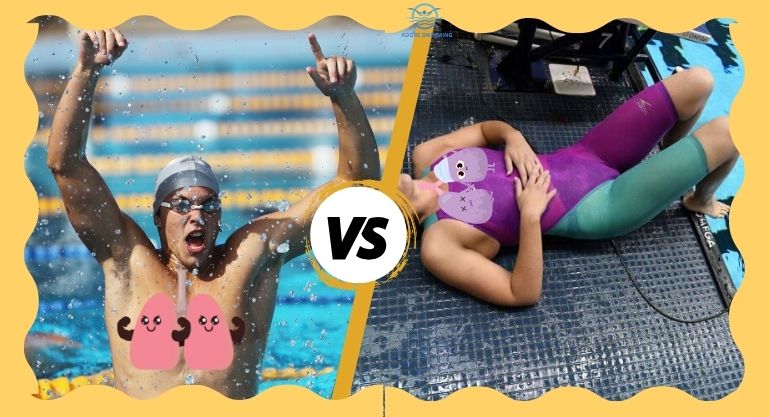Swimmers Lungs vs Normal Lungs | Capacity, Health & Training
So, what’s the real difference between swimmers lungs vs normal lungs? In simple words, swimmers usually have bigger lung capacity, stronger breathing muscles, and better breath control compared to non-swimmers.
This isn’t just from studies — real swimmers confirm it too. On Reddit, one user wrote: “After a year of swimming three times a week, climbing stairs felt easier and I didn’t get out of breath like before.”
Swimmers Lungs vs Normal Lungs: Key Differences
Many people wonder about the real difference between swimmers lungs vs normal lungs. A recent study published in MDPI (2024) shows that trained swimmers usually have larger lung volumes and better breath control compared to non-swimmers.
Here’s a comparison table:
| Aspect | Swimmers Lungs | Normal Lungs |
|---|---|---|
| Total Lung Capacity (TLC) | ~7.0–8.0 liters (elite male swimmers) | ~6.0 liters (average healthy male) |
| Forced Vital Capacity (FVC) | ~6.5 liters | ~5.0 liters |
| FEV₁ (air exhaled in 1 sec) | ~5.5 liters | ~4.0 liters |
| Breath-Holding Time | 2–3 minutes (trained swimmers) | 30–90 seconds (average person) |
| Breathing Muscle Strength | Stronger diaphragm and chest muscles from resistance in water | Normal strength without extra training. |
| Oxygen Use | The body learns to use oxygen more efficiently, so swimmers don’t get tired as fast | Uses oxygen normally; may feel out of breath sooner |
The explanation of the terms in the table:
- Total Lung Capacity (TLC): the maximum amount of air your lungs can hold after taking the deepest breath possible.
- Forced Vital Capacity (FVC): the total volume of air you can exhale after taking a full, deep breath.
- FEV₁ (Forced Expiratory Volume in 1 second): the amount of air you can forcefully blow out in the first second of exhaling — an important measure of lung strength.
Ways to Increase Lung Capacity
If you want to boost your lung strength like swimmers, there are several exercises and techniques you can try.
For example, practicing longer breath-holds, swimming underwater, and controlling your breathing during laps can help improve lung efficiency over time.
For a detailed, step-by-step guide on how to increase lung capacity for swimming, check out this full guide below:
FAQs:
How do competitive swimmers train to increase their lung capacity?
these are the Exercises:
- Swim regular freestyle but only take a breath when necessary, such as every other stroke or once per length
- take a breath every 3, 5, or 7 strokes
- Swim full laps underwater to build breath control and lung strength
- Swim short distances at full effort but restrict yourself to 1–2 breaths per 25m
- Sit or lie down, inhale deeply for 4–6 seconds, hold for 4–6 seconds, exhale slowly.
What are the symptoms of swimmer's lungs?
some swimmers notice things like getting out of breath, coughing, or feeling tightness in the chest during hard workouts. These issues can happen from cold water or pushing your body too much. Always pay attention to how you feel, and see a doctor if the problems continue.
Do swimmers have healthier lungs?
Yes! Swimmers’ lungs are usually stronger than those of someone who doesn’t swim often. Swimmers notice that they experience less fatigue during activities like climbing stairs or running. Swimming regularly helps the lungs work better and makes breathing easier over time.
What is Michael Phelps' lung capacity?
Michael Phelps is known for having very large lungs — about 12 liters, which is twice as big as most people’s lungs
Does swimming detox the lungs?
Swimming doesn’t “clean” your lungs like a detox, but it does make them stronger and work better. Regular swimming trains your breathing muscles and helps your body use oxygen better, which keeps your lungs healthy.



Leave A Comment